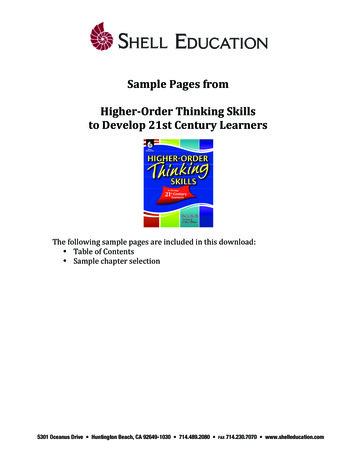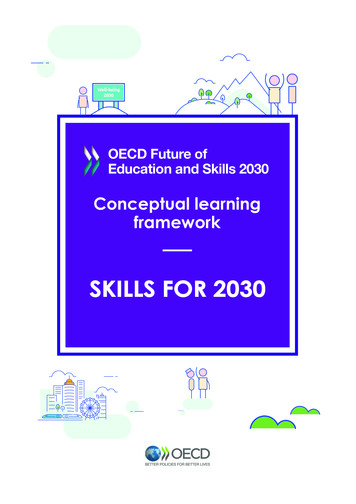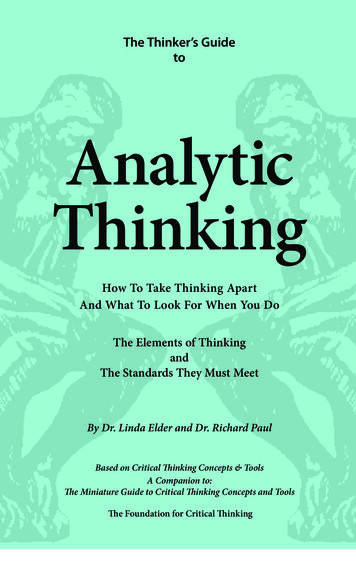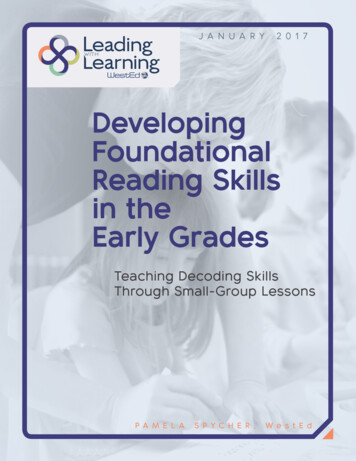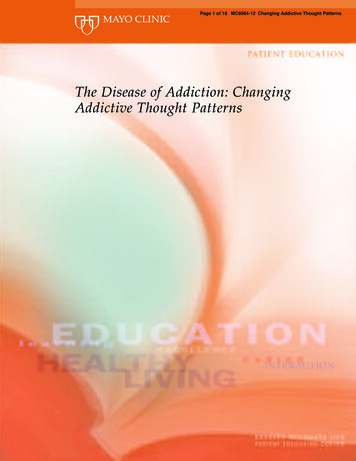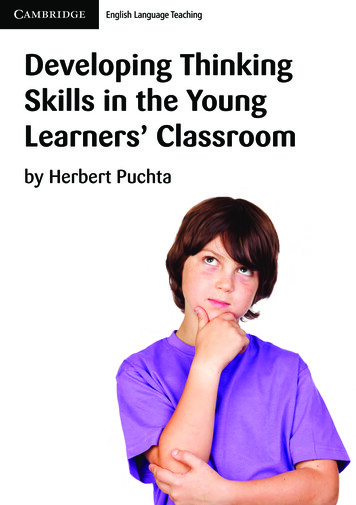
Transcription
Developing ThinkingSkills in the YoungLearners’ Classroomby Herbert Puchta
Looking into a classroomChristopher isn’t easy to teach. He finds it very difficult to focushis attention for more than a few minutes. Even when he’senthusiastic about something, he loses interest in it as soon as heis supposed to tackle a task that is only slightly more challengingthan he can easily cope with. We are not talking difficult tasks atall – it’s just that he seems to want to avoid failure, and thereforequickly loses interest in whatever he is supposed to be doing.In consequence, he doesn’t achieve the results he would like toachieve, and he gets frustrated. He’s also quite impulsive – hereacts without thinking, especially when he’s annoyed with oneof his classmates. Then he can become quite angry, and evenaggressive. When I try to talk to him afterwards, he apologises,but it seems that he doesn’t really understand that he getshimself and others into trouble by not thinking of whatkind of consequences his behaviour might have.2
Sophia is the complete opposite. She’s calm and focused, andwhen she gets interested in something, there’s nothing that canstop her, not even when she doesn’t know how to do things. She’llask me questions, and she tries hard to understand my answers. Ifshe doesn’t know how to solve a task immediately, she’s persistentand keeps trying. I can feel that she really wants to learn, and thatshe believes she can succeed in the task even if things get difficult.So she’s one of the best learners in my class. Sophia’s also verypopular with her classmates, both boys and girls. I think that’s todo with the fact that she’s a good listener.She’s interested in others, asks them questions,and helps them when she notices that they needsomething. It’s good to have her in the class, aswell, because she’s got a good sense of humourand surprises me and the other kids frequentlywith her creative ideas.If you are a teacher of young learners, then you’ve most probablycome across children like Christopher and Sophia. And you may havewondered what it is that makes them so different from one another.An easy explanation would be that Sophia’s just much smarter thanChristopher, and hence achieves better results. In consequence, shemight be more motivated to learn and is also much more efficient indealing with other people. Christopher on the other hand, one mightthink, is less talented. He doesn’t have what it takes to become agood learner. He lacks the skills that Sophia shows, so things for himjust don’t go as smoothly as they do for her.3
What makes successful people?Even extremely successful people are not successful because they were borngeniuses; top entrepreneurs, artists, sports professionals and inventors arenot usually born as peak performers. It seems that what sorts out successfulpeople from the less successful ones is a high level of engagement, an interest in‘getting it right’, patience and persistence. They seem to have the drive to keeptrying in spite of failure, and they show a non-judgemental attitude towardstheir own mistakes – in other words their self-image doesn’t suffer when theydon’t immediately find an answer to a problem. ‘This is not easy. I need to thinkso I can solve this problem,’ said Sophia when confronted with a challengingtask. ‘But that’s fun. Thinking and finding answers to problems is fun.’This is not to say that top performers might not have some natural talentthat makes it easier for them to excel in whatever it is they are doing. Buttalent without persistence often leads to long-term failure or at least underachievement, whereas high levels of engagement and persistence can to acertain extent make up for a lack of talent, and over a longer period of time leadto positive learning experiences, a growing sense of achievement and success!4
Thinking requires developmentThe development of cognitive capabilities in many ways follows the sameprinciples. Robert Fisher, a leading expert in developing children’s thinkingskills, says that thinking is not a natural function like sleeping, walking andtalking. Thinking, he stresses, needs to be developed, and people do notnecessarily become wiser as they become older. Some children are luckybecause they learn important thinking skills from their parents or otherpeople. This works especially well when parents take the child seriously,engage them in meaningful conversations, inspire their imaginations, askthem questions that get them to think and so forth. Other children areless lucky as they do not have such a nurturing environment that fosterstheir cognitive development. However, both children from brain-friendlyfamilies and others who come from less supportive contexts, will profitsignificantly from a teaching methods that takes the development of theirthinking skills seriously.The philosopher Matthew Lipman noticed a lack of reasoning skills in manychildren, and started a movement to involve children in philosophy, an approachthat has spread to many countries of the world. He used the following metaphorto stress the need to systematically develop a child’s thinking skills: when wecompare a car mechanic with an average person who could never repair theirown car, the difference is not that the car mechanic knows how to use toolssuch as a hammer, a screwdriver, pliers, or a wrench. Most average people knowhow to do that too, yet they would fail hopelessly if they were to try to repairtheir car engine. What’s different between them and the car mechanic is not theknowledge of how to use a hammer, a screwdriver or a wrench. What the carmechanic knows, and what average people don’t, is how to sequence the use ofthese tools in a way that leads to the planned outcome. The car mechanic knowswhat they are doing, and why they are doing it; and when what they are doingdoes not give them the planned outcome, they keep trying to come up withalternative strategies that are bound to lead to eventual success.5
Applying thinking skillsThe same is true of cognitive skills. So-called higher-order thinking skills– such as problem-solving – are not completely different skills from thelower-order ones, but are merely a combination of those basic skillsused in a specific way. When we try to solve a problem, we first of allneed to observe carefully what the ‘symptoms’ of the problem are. Weneed to use our senses in an accurate way to do that, focusing on whatwe can, for example, hear and see. We need to have the ability to focusour attention over a longer period of time, and we need to set ourselvesa goal. We need creative skills and the ability to look at a problem fromdifferent perspectives, and we need to think carefully what outcomes aplanned chain of actions might possibly result in. We need to come up withalternative strategies if what we are planning to do turns out to be the wrongstrategy. When we have finally decided on what to do and how to go about it,we need to be able to evaluate what we have done and, if necessary, go back andundo what we’ve done or apply an alternative strategy.When children get used to systematically applying their thinking skills, they willgo through positive learning experiences, and they will gradually learn to enjoymore challenging tasks. As a result, their self-confidence will grow.6
Thinking skills: three modelsThere are many different models aimed at explaining what the thinkingprocess consists of, how children’s thinking skills can be developed andwhat we as teachers can contribute to their development. I would like tobriefly present three of these models, and discuss how they can be appliedin the foreign language class, so that learners’ cognitive skills can bedeveloped alongside their foreign language skills and competencies.Model 1: Language and the development ofcognitive toolsThis model, developed by Kieran Egan on the basis of Vygotsky’s work,stresses the focal role that the child’s language development plays inunderstanding the world through the use of language-based intellectualtools or capacities. The teaching of literacy, according to this model, canbe made more efficient through our understanding of the concept ofcognitive tools and through applying these insights to what we do in theclassroom. It’s not difficult to see that this model – although designed formother-tongue literacy development – has significant relevance for theforeign language class as well.Egan (1997) postulates that a person’s intellectual growth happensnaturally, through the acquisition of certain intellectual qualities (he callsthem ‘developments’) deeply rooted in our cultural history. In order foran individual’s intellect to grow appropriately, the development of certain‘cognitive tools’ is essential. Here is a very basic summary of his insightswhich are relevant as a basis for understanding how the human minddevelops during childhood.7
Rhythm and rhymeIn pre-literate days, people were expected to have the ability toremember pieces of text of sometimes epic length. Rhythm and rhymewere important mnemonic devices in that process. In the same way, itis through rhythm and rhyme that children start remembering chunksof language from an early age, and they usually develop enormous joythrough repeatedly hearing (and later speaking along with) the samerhymes over and over again. This way, children begin to develop anunderstanding of patterns – the sound patterns of language first – andform the cognitive tools needed for the understanding of structures.Images and imaginative thinkingFor the young child, there is no borderline between reality andimagination. If the teacher uses a glove puppet, to name one example,a six-year-old recognises it as a puppet, and yet, as soon as the puppetstarts ‘talking’ (through the teacher’s voice of course), the child goes into adreamlike state of mind – and is convinced the puppet has become alive.Such imaginative processes lead to the creation of images in the child’smind. This is important, because understanding oral (and later written)language requires not only knowledge of words, but also the ability tocreate and use mental images, enabling the learner first to understandtexts in the foreign language better and later to recall more informationfrom these texts. There is clear evidence that learners who are at easewith creating lots of images while listening to (or later reading) a story, forexample, remember more language from the story.Story thinkingEgan points out that stories play an essential role in the cognitivedevelopment of children. He stresses that the story form is somethingpeople in all cultures enjoy. Stories, however, function as more than mereentertainment – they help the child develop an understanding of the worldand their own life experiences.8
But a word of caution seems appropriate; there are certain criteria that apiece of text needs to comply with in order to qualify as a story – and moreoften than not in language teaching materials we come across a so-calledstory that just doesn’t deserve to be called that. Here’s an imaginary (andexaggerated, I hasten to add) example. We have a story in which we arepresented with a boy and a girl, Annabel and Oliver. They greet each otherin a friendly way and introduce themselves to each other. Then Oliverintroduces some of his family; this is my uncle, James, and that’s my aunt,Emma. (We can see Aunt Emma, by the way, standing on the other side ofa nearby river, which is fortunate, as it helps to justify the deictic use of‘that’.) Annabel wants to follow suit, and luckily she has her brother andher sister at hand; this is my brother, Benjamin, and that’s my sister, Kylie. Itseems that such excessive social protocol makes both of them hungry otherwise why else would Oliver then say; now let’s eat this cake.? Luckily,Annabel knows better: no, let’s eat that cake. The ‘story’ evolves furtherwith the two kids suggesting and counter-suggesting a number of otherfood items, and it comes to a bizarre round-up when Benjamin suggeststhey should have an ice cream, leading to Annabel’s final utterance, thewarning; but don’t be greedy.9
What is called a story here is anything but – and we can easily prove that if weuse Egan’s criteria for the kinds of elements a story needs to contain in orderto engage the young listener or reader. First of all, a story needs to engage thereader or listener emotionally, and in order to do so it needs a clear beginning(setting the scene), a middle part (where things develop in an unexpected way,leading to conflict and hence emotional engagement) and an end (where theconflict gets resolved). The story only works if there is some kind of tension – anunexpected turn, a complication of the plot, a surprise element, or somethingthat shocks the reader or listener, making him or her feel worried, sad, etc. Forthat, we need what Egan calls binary opposites that create strong emotionalcontrasts, contraposing concepts such as good and bad, rich and poor, happyand sad, tiny and huge. So if Oliver has a dog that gets bitten by a poisonoussnake while he is involved in his social chit-chat with Annabel, the reader orlistener finds themselves in a story all of a sudden. Will the dog survive? What willthe children do? Are they themselves in danger? are some immediate thoughtsthat show the reader’s or listener’s engagement. The protagonists, however,don’t have time to consider these questions at length. As soon as they begin tounderstand how serious the situation is, Annabel remembers her aunt, a wise oldwoman. When the children seek her advice, she suggests they go to a place highup in the mountains where they can find a tree with golden apples, one of whichthe dog should eat. They manage to find the tree and the dog is saved.It’s not difficult to imagine which of the two versions of a story will engagechildren more. But unfortunately, when ELT authors create stories they all toooften have language alone in mind. Story relevance doesn’t seem to matter,because the ‘story’ is seen merely as a vehicle for the language. In our inventedexample, the language elements which the author wants to pack into the storyare deixis (this and that); making suggestions (Now let’s eat this cake.), andmaking an alternative suggestion (No, let’s eat that cake.). But it’s not difficultto guess that that text will fail to gain the attention of the learners and becausethere is nothing memorable about the story, little of its language will remain intheir memory.Stories, Egan stresses, communicate information and at the same time help usto understand how to feel about it; and that’s why they are so powerful – more10
powerful than any other form of language. Only stories can have such lastingeffects on the recipients, and that’s why we use stories all the time in real lifeto convey meanings. We use stories to impress others, to make friends, tojustify behaviour and give reasons for it, to influence people, to supportand to entertain.Humour and small talkUsing humour in the foreign language class is more than having somethingto laugh about, and engaging in small talk is not just an exchange of linguisticformalities – both are actually very important for the development of thechild’s cognition. Children love jokes, and trying to understand jokes and punchlines is often the child’s first attempt at thinking about language. The ability tounderstand double meanings, puns and word play are important building blocksof the child’s cognitive development, as is the ability to engage in small talk. Thelatter has an important social function and that is why children need to learn totake part in it. However, successful participation in small talk situations is alsoimportant because it strengthens the child’s self-image and gives the child afeeling of social security and acceptance. Being accepted by their teacher andclassmates is an extremely important experience for the child, and at the sametime it is a precondition for developing social relationships and friendships.11
Model 2: Multiple intelligencesThrough his pioneering research into human intelligence, Howard Gardner,professor of education at Harvard University, has clearly shown that thereis no such thing as a single unitary mental capability that can be calledintelligence, but that there are instead multiple intelligences (MI). Heargues very convincingly that IQ tests and schooling in general usuallyassess just two of the human intelligences, the linguistic and the logicalmathematical. Gardner, however, proposes eight different intelligences,accounting for a much broader spectrum of human capabilities that ourthinking skills draw on:Intra-personal: self-smartInter-personal: people-smartLogical-mathematical: maths-smartLinguistic: language-smartMusical-rhythmic: music-smartVisual-spatial: picture-smartKinaesthetic-bodily: body-smartNaturalistic: nature-smart12
MI in the ELT classroomOne could argue, of course, that EFL primary classrooms have, to a certainextent, always been MI ones. However, we need to be careful not to mixup multi-sensory teaching with MI teaching. In other words, using picturesin the foreign language class is not necessarily about teaching from thevisual-spatial intelligence any more than singing a song with the childrenwill automatically activate their musical-rhythmic intelligence. As Gardnersaid in an interview (Edutopia 1997):‘I remember seeing a movie about multiple intelligences and therewere kids crawling on the floor and the legend said ‘bodily-kinaestheticintelligence’. I said, ‘That’s not bodily-kinaesthetic intelligence, that’s kidscrawling on the floor. This is making me crawl up the wall! [ ] to have kidscrawl or exercise their vocal cords, that’s not intelligence.’In the same interview, Gardner stresses the importance of deciding whatour educational goals are, and – once we have determined what theyare – considering how we can help our children achieve them better. Theconcept of MI cannot itself be a goal any more than singing a song, usingpictures, getting learners to move around the classroom, etc. – but it canhelp us achieve our goals better. If my goal is, for example, to revise alexical set with a beginners’ class of six-year-olds, I can do this in variousways. Below is one suggestion that you might want to try; it is based on MIthinking and while it is an interesting and highly motivating activityfor those kids whose mathematical-logicalintelligence is in good condition, it is infact useful for all your learners sinceit helps develop important thinkingskills at the same time as working toaccomplish your goals.13
An example – lexical revision throughlogical sequencesLet’s assume the words you want to revise are butterfly, frog, flower, bee,tree, ladybird and sun. Draw logical sequences, as below, of the words youwant to revise on the board or give each learner a photocopy of them.Read the first row out together with the learners rhythmically:butterfly - frog - butterfly - frog - butterfly - frogElicit the missing word (butterfly) and ask them to complete the rowby drawing a picture of the missing word. Give them a few minutes tocomplete the other rows. If they cannot complete the patterns, get themto talk to at least three other children about their solutions and why theyhave come up with them. These discussions will naturally happen in thechildren’s mother tongue. When they have finished, ask two children toread out the solutions to the class so that they can all check.Ask them to put numbers against the rows: 1 against the top row, 2 againstthe one underneath and 3 against the bottom row. They then put theirworksheets on their desks face down.Ask a learner to read out any one of the three rows. When they havefinished, the others turn over their worksheet and say which number they14
believe the row was. Repeat the activity several times. Then challengelearners to see if they can tell which of the rows has been read out withoutlooking at the worksheet. Give them about a minute to look at theworksheet and try to memorise the rows before they put it face down onthe desk again.Next, hand out a paper strip with a copy of three empty rows to each childand ask them to create their own logical sequences, using any of the wordsthey know in English that can easily be drawn. (Alternatively and withslightly higher level classes, learners could also write the words.) Tell themto leave one or two frames free in each row. Collect all the paper strips in,and repeat the activity using the children’s own logical sequences.Developing cognitive processesWhen you regularly use activities like this in your class, you will notice thatchildren gain confidence in figuring out how a task works. If guided properly– will develop an attitude that can best be summed up with what one child inan MI classroom said, ‘Ah. That’s not easy. I need to think first!’ At the sametime, there is a clear language gain – in this case, revision of a lexical set. Butthere is more to it. If you work on children’s thinking skills on a regular basis, thedevelopment of their thinking skills will also enhance cognitive resources thatsupport the child’s language learning.To return to the example activity, we can say that in order to understand patternsthe logical-mathematical competencies are needed. So what we are developingthrough this simple activity is a basic skill that is going to be called into actionagain later on, when the child is required to understand the patterns of language.Any metalinguistic task that learners might be asked to engage with later in theirlanguage learning process is likely to require this and other basic cognitive skills,e.g. noticing patterns, drawing conclusions, hypothesising and verifying one’shypotheses. These cognitive processes are needed later in the language learningprocess. An example is the type of task that asks learners to notice grammarphenomena and try to come up with rules describing them. To do this, learnersneed to do exactly what has been described above – i.e. noticing linguisticpatterns, and trying to find the rules that govern them by making hypotheses andverifying or disproving the rules they have come up with.15
Model 3: Combining the teaching of thinkingwith language teachingBased on Feuerstein’s Instrumental Enrichment Programme and the workdone by Blagg and his associates (2000), my colleague Marion Williams and I(2011) have developed a model of thinking skills work that takes into accountthe specific needs of the foreign and second language class. Our approachincorporates two significant advantages. First, activities that are meaningful andat the same time intellectually challenging are more likely to achieve a higherlevel of cognitive engagement from learners than those ELT activities that canbe somewhat over-simple from a cognitive point of view. Secondly, the tasks wehave developed have a real-world purpose; examples include problem solving,decision making, thinking about the consequences of one’s own or other people’sactions, and so on.As happens every day in our personal and professional lives, each of thesereal-world purposes requires a combination of thinking skills. When there is aproblem we need to solve, we first of all need to assess what the actual problemis. We need to use our senses in order to get an accurate idea of what theproblem is before we can start thinking of possible solutions. Once we knowwhat the problem encompasses, we then need to envisage clearly the objectiveswe want to achieve, and how we can get there. In order to do that, we need tothink of the consequences of possible scenarios or actions, and when we getstuck we need to think creatively (and often ‘out of the box’). Finally, we need tobe able to evaluate our actions.16
Activity types to develop thinking skillsand languageWe have developed 13 categories of activity that help with both thedevelopment of the learners’ thinking skills and their language. They roughlyfollow a cline from basic to higher-order thinking skills:Making comparisonsCategorisingSequencingFocusing attentionMemorisingExploring spaceExploring timeExploring numbersMaking associationsAnalysing cause and effectMaking decisionsSolving problemsCreative thinking17
An example activityLet’s look at an example from the category ‘Making decisions’ that demonstrateshow closely thinking and language work are dovetailed in our approach.In the activity Who’s got an idea? learners get a worksheet showing eightsituations. The learners are asked to look at the pictures and think about what theproblem in each picture is and what the people in the various situations shoulddo. Here’s an extract from one of the classes that piloted our materials:T:What about picture one? What’s the problem?S1: Vase. The boy playing in the house and vase break.T:Uhuh. The boy was playing and he broke the vase.(writes it on the board)S2: The mother angry.T:OK, you think the problem is that the boy’s mum’sangry. (writes it down) Where’s the mother?Making decisionsS2: She comea minute.Who’sgotinanidea? Worksheet1What’s the problem in each picture? What should the people do? Think of asT: OK. Any other idea?many ideas as you can.2S3: Yes,the thecat bestbreaktheSayvase.Thenchooseidea.why you think it’s the best idea.T:I see. So the boy found thebroken vase on the floor.The cat broke it.S4: Yes, the problem is that themother say the boy broke it.T:18You think the boy’s mumdoesn’t believe it was thecat that broke the vase. I see.
We can see that the learners are fully engaged in thinking about what theproblem is. The teacher facilitates the learners’ language by helping them toexpress what they want to say, and by clarifying meaning rather than reacting tothe way they say it. This is an important step and prepares the class for the nextphase, when learners will make suggestions about what the boy in this situationshould do. Learners then think about which of the suggestions made is the bestone and give their reasons.It is easy to see how this approach helps with both the child’s cognitive andlinguistic development and at the same time gives the teacher plenty ofopportunity to take the learners seriously. This in turn sends out very importantmessages to the learners, enabling them to develop feelings of competence andserious involvement in their work.The classroom discourse that arises from this work creates the need for‘scaffolding’. The teacher listens and as the language emerges, supports thespeaker in a positive way, as well as helping the other learners to understandwhat the speaker is saying.ReferencesBlagg, N. (2000) Can We Teach Intelligence? A comprehensive evaluation of Feuerstein’s InstrumentalEnrichment Programme Lawrence Erlbaum Associates: Hillsdale, New JerseyEgan, K. (1997) The Educated Mind: How Cognitive Tools Shape Our Understanding. Chicago:University of Chicago PressFeuerstein, R and Jensen, M. (1980) ‘Instrumental Enrichment: Theoretical Basis, Goals, and Instruments’ inThe Educational Forum, 44 (4).Gardner, Howard. (1983) Frames of Mind: The Theory of Multiple Intelligences. New York: Basic BooksPuchta, H. and Williams, M. (2011) Teaching Young Learners to Think. Innsbruck and Cambridge:Helbling Languages and Cambridge University PressAbout the AuthorDr Herbert Puchta is a full time writer of course books and otherELT materials and a professional teacher trainer. For almost threedecades, he has researched the practical application of cognitivepsychology in EFL-teaching and has co-authored numerous coursebooks and resource books including for Primary: Playway to English(Cambridge-Helbling), Join In/Join Us (Cambridge-ELI), and Super Minds(Cambridge); and for Secondary: MORE! (Cambridge-Helbling) andEnglish in Mind (Cambridge).19
Everyone’s a superhero withThe new English course thatenhances children’s thinkingskills and lableTeaching Young Learners to ThinkHerbert Puchta and Marion WilliamsActivities with photocopiable worksheets and easy-to-follow teacher’snotes promote the basic thinking skills young learners need as theygrow older.Please order through your usual ELT bookseller. In case of difficulty,contact your local Cambridge University Press office or write to:facebook.com/CambridgeUPELTELT Marketing, Cambridge University PressThe Edinburgh Building, Cambridge CB2 8RU, UKtwitter.com/CambridgeUPELTTel: 44 (0)1223 325922Fax: 44 (0)1223 325984youtube.com/CambridgeUPELTISBN: 978-1-107-91543-5Printed in the United Kingdom on elementalchlorine-free paper from sustainable forests. 2012.
Thinking requires development The development of cognitive capabilities in many ways follows the same principles. Robert Fisher, a leading expert in developing children’s thinking skills, says that thinking is not a natural function like sleeping, walking and talking. Thinking



